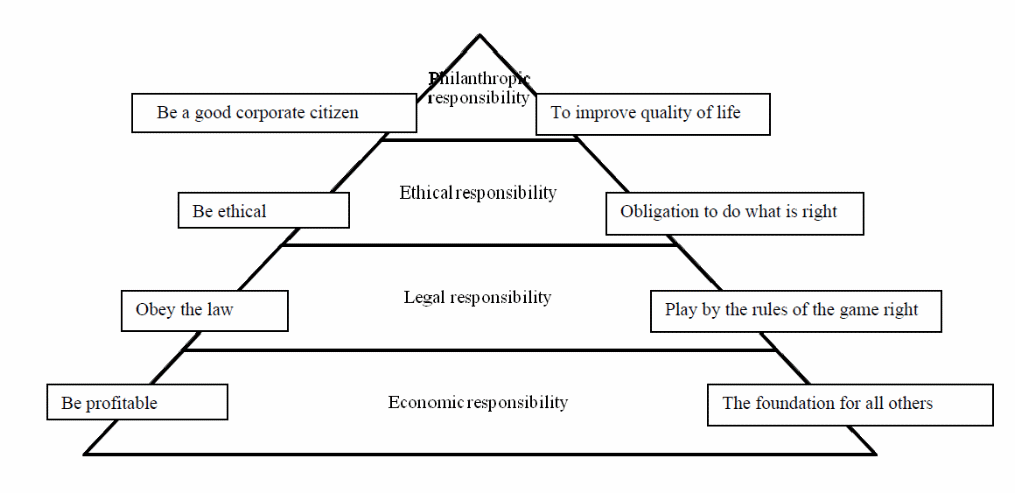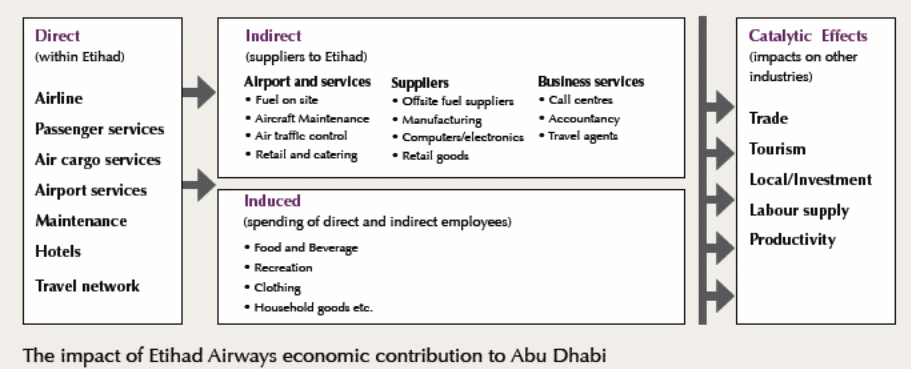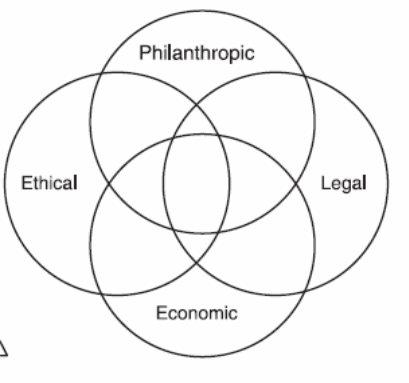Introduction
The demanding and fast-paced business environment of modern economies has created several shifts in business working paradigms. Corporate Social Responsibility (CSR) is one business paradigm that has emerged from these changes. As such, Sharma and Kiran (18) say CSR has become a growing area of interest for researchers, businesses, and practitioners (in terms of its theoretical and practical underpinnings).
Although few scholars agree on the proper definition of CSR, Sharma and Kiran (18) define it as “a concept whereby companies integrate social, environmental, and health concerns in their business strategy (policy) and operations, and in their interactions with stakeholders” (18). The above definition shows that the society often has legal, economic, and ethical expectations (from companies).
These expectations are more profound for multinational organisations because they have the greatest impact on the society. Consequently, people expect many multinational organisations to take part in CSR projects. For example, airline companies have increasingly come under sharp scrutiny because of their environmental impact and cross-border activities. However, such companies have responded by participating in many CSR responsibilities. Etihad Airways (6) is one such company.
Founded in 2003, by a Royal Decree, the airline has become among the fastest-growing airline companies in the world. Based on its stature as a premium airline brand, Etihad Airways (6) operates as the national flag carrier of the United Arab Emirates (UAE).
The airline mainly operates a fleet of more than 88 planes from Abu Dhabi (the capital of the UAE). From this place, the airline flies to more than 84 destinations around the world (spanning across the Middle East, Africa, North America, Asia, Europe, and Australia) (Etihad Airways 6).
Etihad’s vision is to give quality airline services by blending the best of Asian and Western hospitality. However, the airline’s sustainability vision is “To be recognised as a sustainable airline that operates to the highest standards of safety, with integrity and transparency” (Etihad Airways 8).
Etihad Airways (8) also strives to adopt new and unconventional hospitality practices. This goal is part of the airline’s commitment to introduce “freedom” to air travel by practicing the highest global standards in this respect. In line with its vision, the airline also strives to provide safe and environmentally friendly air travel to its customers, by being in-touch with customer needs.
This paper seeks to investigate and understand Etihad’s CSR practices. In doing so, this paper consults several models and theories, such as the pyramid of corporate social responsibility, intersecting circles CSR model, and the instrumental theories (shareholder maximization theory).
These theories categorise Etihad’s CSR initiatives into economic responsibilities, legal responsibilities, ethical responsibilities, and philanthropic responsibilities. Although they show that the airline’s CSR initiatives mainly focus on meeting ethical responsibilities, they also affirm the economic values of its CSR projects. The last section of this paper recommends key improvements to the company’s CSR practices.
Analysis
CSR Pyramid
Among the most known scholars in CSR studies is Archie Carroll. He introduced a systematic model for analysing CSR practices by formulating a pyramid that defines key organisational responsibilities in CSR practice. The diagram below shows his layers of CSR responsibilities that include economic responsibility, legal responsibility, ethical responsibility, and philanthropic responsibilities, in that order.

Figure One: The Pyramid of Corporate Social responsibility (Source: Sharma and Kiran 19)
As shown above, the economic responsibility outlines an organisation’s need to make profits. This is the foundation for all other levels of corporate social responsibilities. The legal responsibility outlines an organisation’s need to obey all laws – playing by the rules. This requirement provides the foundation for ethical practices – obligation to do what is right (Sharma and Kiran 19). Organisations that meet this need (could) also meet their philanthropic responsibilities of being a good corporate citizen and improving the life quality of their stakeholders.
Many organisations that engage in CSR responsibilities have met the above CSR responsibilities. However, the focus on the ethical and philanthropic responsibilities is a recent development. Therefore, in the past, many organisations focused on meeting their economic and legal responsibilities only.
Relation of Carroll’s Model to Etihad’s CSR Strategy
Environmental Responsibility
Etihad’s CSR strategy shows that it meets Carroll’s ethical responsibility level. Particularly, its focus on environmental sustainability shows its compliance with its ethical obligations because it outlines the organisation’s quest to do what is right (being ethical). This compliance level comes in the wake of the environmental concerns about carbon emissions from the aviation industry.
Etihad has responded by developing an environmental policy, developed through a collaborative effort among its stakeholders – partners, suppliers, and customers (Etihad Airways 22). Although this CSR strategy mainly aims to adopt environmentally friendly practices, it broadly fits within a wider “sustainability” model that strives to embrace new technologies in propelling the organisation’s activities. For example, the company strives to use cleaner fuels, such as biofuels, to power its aircrafts.
Similarly, the company aims to start a comprehensive waste management program to inform its customers about the advantages of disposing waste in an environmentally sustainable way (Etihad Airways 22). Comprehensively, Etihad’s environmental sustainability strategy covers three important areas – carbon management and measuring emissions and materiality.
For example, despite the significant progress made by commercial airlines in adopting environmentally friendly practices, the airline industry has continued to receive immense pressures to cut its carbon footprint.
Etihad Airways has been a leader in this regard by reducing its carbon footprint (in its airline operations, and administrative activities). The company does so by measuring its carbon footprint through the greenhouse gas protocol (Etihad Airways 22).
These activities outline parts of the company’s environmental policy that strive to abide by all environmental legislations, install measurement systems to track and change the organisation’s environmental performance, reduce the dependency on traditional fuels, train employees to embrace environmental sustainability, and communicate the organisation’s performance (about environmental sustainability) to all stakeholders. These initiatives outline the company’s ethical responsibilities.
Legal Responsibility
Complying with existing environmental laws highlights Etihad’s legal responsibility in Carroll’s CSR model. Indeed the company’s 2011 CSR report affirms its commitment to work with industry bodies such as “The Civil Aviation Organization (ICAO), the International Air Transport Association (IATA), the Arab Air Carriers Organisation (AACO) and with local government and non-governmental partners” (Etihad Airways 14).
Etihad’s legal responsibility also stretches to its health and safety standards. For example, the company’s safety and quality department complies with all existing standards regarding the health and safety of its employees and customers (Etihad Airways 14). This commitment has reaffirmed the airline’s presence in the corporate aviation map.
For example, the company’s sustainability report affirms the organisation’s presence in several global bodies, including the “Environmental Committee of lATA and the Environmental Policy Group of the Arab Air Carriers Organisation (AACO)” (Etihad Airways 20). Besides complying with existing legislation regarding environmental sustainability, Etihad also plays a proactive role in influencing existing legislations by collaborating with other airlines in developing new legislative frameworks.
Economic Responsibility
Etihad plays a crucial role in improving Abu Dhabi’s economy. For example, the company complements the Emirate’s trade and tourism sectors by acting as a global ambassador for Abu Dhabi. This contribution complements Abu Dhabi’s vision 2030 plan, which strives to diversify the Emirate’s economy by expanding non-oil economic sectors (Etihad Airways 22).
A study by UK’s think tank, Oxford Economics, shows that Etihad’s contribution to Abu Dhabi’s economy covers diverse sectors including “Trade, tourism, location investment, labour supply and productivity” (Etihad Airways 22). The same study revealed that the airline contributed about $6.1 billion to the Abu Dhabi economy (Etihad Airways 14). This amount accounted for about 9.1% of the country’s non-oil GDP.
Progressively, the company’s contribution to the Abu Dhabi economy has increased (over the years) because in 2010, Etihad contributed about 3.7% of the Emirate’s GDP. Besides this contribution, it has also created more jobs than other national companies have done. For example, Oxford Economics shows that the company created about 97,472 jobs in the non-oil sector (Etihad Airways 22). About 6,631 of these jobs directly support the organisation’s activities.
The same UK firm shows that in 2010, Etihad created about 14, 236 jobs from its direct and indirect business interactions with independent Abu Dhabi businesses (Etihad Airways 22).
Roughly, through these business interactions, the company makes an indirect contribution of about $763 million to the Abu Dhabi economy. Indirectly, the company’s contribution to the economy contributes a further $661 million to Abu Dhabi’s economy (based on the expenditures made by the company’s employees and suppliers) (Etihad Airways 22).
Philanthropic Responsibilities
Etihad’s contribution to Abu Dhabi also includes non-monetary contributions. For example, the company markets the Emirate as a top tourist destination, globally. In 2011, the company launched the “Essential Abu Dhabi” marketing campaign to promote Abu Dhabi as a favourite tourist destination. The campaign involved painting aircrafts with a “Visit Abu Dhabi” logo. Several new aircraft had the logos.
The campaign brought together several tourist stakeholders in Abu Dhabi and created a joint marketing effort (Etihad Airways 22). For example, the Abu Dhabi Tourism Authority participated in the campaign. Part of the marketing campaign included a spirited effort to promote Abu Dhabi’s cultural heritage.
For example, the airline gives opportunities to women from marginalised communities to sell traditional crafts in the duty-free on-board flights (Etihad Airways 22). This way, the airline creates employment for marginalised communities. Overall, the following diagram sums Etihad’s contribution to Abu Dhabi.

Figure Two: The Impact of Etihad’s Economic Contribution in Abu Dhabi (Source: Etihad Airways 22)
Instrumental Theories
Instrumental theories suggest that most organisations only take part in CSR activities for economic gain. This view emerges in Friedman’s conception of CSR activities when he says ‘‘the only one responsibility of business towards society is the maximization of profits to the shareholders, within the legal framework and the ethical custom of the country’’ (Garriga and Mele 53).
This view also suggests that the motive for wealth creation would overshadow the gains from managerial responsibility. Some researchers have argued that this principle promotes the concept of stakeholder value maximization (Garriga and Mele 53). However, it does not presuppose excluding other stakeholders’ interests from the analysis.
Garriga and Mele (53) say that profit maximization outlines one group of instrumental theories, which supports incremental share prices as an “ultimate” CSR goal. Coincidentally, this group of theories outlines the main motive of Etihad’s CSR initiatives. For example, the company’s CSR initiatives aim to promote Abu Dhabi’s “beauty” to the rest of the world.
However, they underlie significant economic gains for the airline and the Abu Dhabi Emirate. For example, the marketing campaign aims to attract more visitors to Abu Dhabi. This translates to more tourist numbers and a resultant growth in the tourism industry (by extension, the growth of the non-oil sector).
Such developments portend several economic gains for Abu Dhabi. Furthermore, considering a Royal Decree established Etihad Airways, correctly, the airline shares a close relationship with the government. Therefore, marketing Abu Dhabi to the rest of the world is a profitable venture for the government, which is Etihad’s main shareholder. This analysis shows how the instrumental theories apply to the airline’s CSR practices because its CSR activities aim to maximise shareholder value (the Abu Dhabi government is the key shareholder).
Etihad Airways (22) would also gain from similar marketing initiatives because its marketing campaign translates to more customers (more tourist numbers) because the airline is a significant player in Abu Dhabi’s aviation industry. This assessment shows that Etihad Airways (22) and the Abu Dhabi government benefit economically from the airline’s CSR activities.
Intersecting Circles CSR Model
The intersecting circles CSR model shares a close relationship with Carroll’s CSR model because both frameworks explain CSR practices, based on their philanthropic, ethical, economic, and legal attributes.
However, unlike the pyramid model, the intersecting circles CSR model shows interrelationships among CSR domains (Geva 15). Similarly, the intersecting circles CSR model does not follow a hierarchical model of CSR importance, as outlined by the pyramid model. The diagram below shows the intersecting relationships among different CSR responsibilities.

Figure Three: Intersecting Circles CSR Model (Source: Geva 5)
Although the pyramid model described shows the nature of Etihad’s CSR responsibilities, the intersecting CSR model provides a better conception of these responsibilities. Particularly, this model shows how the airline’s CSR responsibilities overlap each spectrum of CSR analysis.
For example, the pyramid model describes the airline’s environmental sustainability practices, as part of the company’s ethical responsibilities. However, the intersecting model shows the possibility of this CSR practice overlapping on another CSR responsibility. For example, the company’s adoption of environmentally sustainable CSR practices overlaps the ethical and economic CSR spectrums.
Indeed, Etihad Airways (14) has collaborated with several institutions of higher learning, in Abu Dhabi, to explore the use of “green” energy. As explained in this paper, the airline aims to reduce its reliance on traditional fuels to reduce its carbon emissions. However, this strategy is not purely ethical (the company could benefit from it economically). For example, the use of biofuels would (possibly) provide a cheaper and alternative fuel for the airline.
This would result in significant cost reductions for the company, especially considering the aviation sector suffers from increased costs of operations, partly contributed by increased fuel costs. Therefore, as the airline cuts its carbon footprint by adopting greener energy, it could cut its operational costs. Overall, this analysis shows overlapping CSR spectrums, as outlined by the intersecting model.
Conclusion and Recommendations
Conclusion
This paper sought to evaluate the CSR practices of Etihad Airways (6) by comparing and contrasting them to CSR models and theories. Carroll’s CSR pyramid explained the airline’s CSR practices by categorising them into four distinctive CSR groups (economic responsibility, legal responsibility, ethical responsibility, and philanthropic responsibility). Etihad’s CSR responsibilities mainly lie in the ethical and legal categories.
A deeper review of the company’s main CSR initiatives shows a strong focus on environmental sustainability as the main CSR focus. Therefore, its environmental responsibilities overshadow its philanthropic and economic responsibilities. In fact, the company’s CSR report shows minimal and scanty philanthropic initiatives.
The intersecting circles CSR model shows how the airline’s sustainable practices cut across ethical and economic spectrums. The pyramid model was unable to show this relationship because it does not recognise overlapping CSR spectrums. Instead, it broadly categorised the CSR initiatives into the four categories described above. Instrumental theories show that the company’s main CSR practices have an underlying economic gain for the shareholders.
The business also benefits in this regard. The airline’s political connections outline the greatest evidence supporting this fact because ties to the UAE government creates an opportunity for Abu Dhabi and the airline to benefit from joint marketing activities (managed by the airline and government bodies, like the Abu Dhabi Chamber of Commerce).
Based on the economic benefits emerging from this analysis, and the findings of the intersecting circles CSR model, it is pertinent to state that Etihad stands to benefit economically from most of its CSR initiatives. This finding further strengthens the findings of the instrumental theories, which suggest that the motive to create wealth often overrides social or non-profitable interests.
Recommendations
Already, this paper shows that Etihad’s CSR initiatives mainly focus on promoting the adoption of environmentally sustainable activities. Marketing initiatives outline other CSR projects that aim to create awareness about the “beauty” of Abu Dhabi. These analyses show that the airline has a narrow CSR focus.
Therefore, it needs to expand its CSR scope to include more initiatives. For example, besides focusing on environmental issues only, the company could introduce other aspects of CSR practice, like introducing ethical labour practices or engaging in more practices that are philanthropic.
Particularly, the company should focus more on venturing into CSR initiatives that strive to improve employee well-being and engagement. Similarly, the airline could expand its CSR scope and include diversity and social equity programs. Overall, these initiatives should aim to improve the community’s well-being and economic prosperity.
Works Cited
Etihad Airways 2011, CSR Report 2010. Web.
Garriga, Elisabet & Mele Domenec. “Corporate Social Responsibility Theories: Mapping the Territory.” Journal of Business Ethics 53.1 (2004): 51–71. Print.
Geva, Aviva. “Three Models of Corporate Social Responsibility: Interrelationships between Theory, Research, and Practice.” Business and Society Review 113.1 (2008): 1–41. Print.
Sharma, Anupam & Kiran Ravi. “Corporate Social Responsibility: Driving Forces and Challenges.” International Journal of Business Research and Development 2.1 (2013): 18‐27. Print.